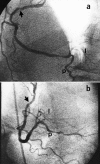Use of indicative and reciprocal electrocardiographic changes to help localize the site of coronary occlusion
- PMID: 16369596
- PMCID: PMC1291319
- DOI: 10.1080/08998280.2001.11927740
Use of indicative and reciprocal electrocardiographic changes to help localize the site of coronary occlusion
Figures



References
-
- Birnbaum Y, Sclarovsky S, Mager A, Strasberg B, Rechavia E. ST segment depression in aVL: a sensitive marker for acute inferior myocardial infarction. Eur Heart J. 1993;14:4–7. - PubMed
-
- Casas RE, Marriott HJ, Glancy DL. Value of leads V7–V9 in diagnosing posterior wall acute myocardial infarction and other causes of tall R waves in V1–V2. Am J Cardiol. 1997;80:508–509. - PubMed
-
- Zalenski RJ, Cooke D, Rydman R, Sloan EP, Murphy DG. Assessing the diagnostic value of an ECG containing leads V4R, V8, and V9: the 15-lead ECG. Ann Emerg Med. 1993;22:786–793. - PubMed
-
- Boden WE, Kleiger RE, Gibson RS, Schwartz DJ, Schechtman KB, Capone RJ, Roberts R. Electrocardiographic evolution of posterior acute myocardial infarction: importance of early precordial ST-segment depression. Am J Cardiol. 1987;59:782–787. - PubMed
-
- Marriott HJL. Pearls and Pitfalls in Electrocardiography. Philadelphia: Lea and Febiger; 1990.
LinkOut - more resources
Full Text Sources
